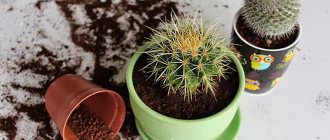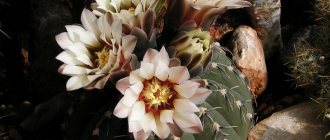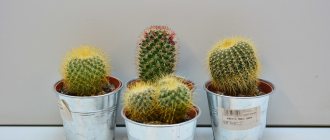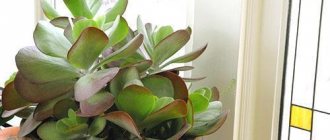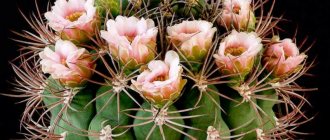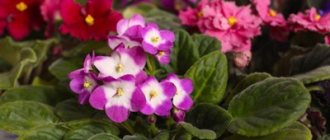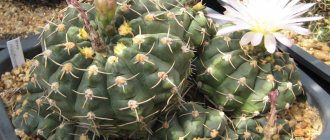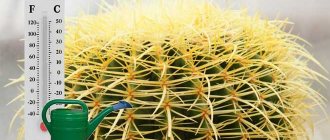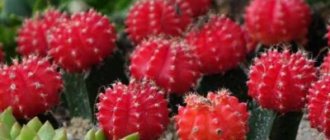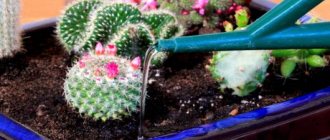The Gymnocalycium cactus can be called a pioneer among the spherical representatives of these succulents in indoor floriculture. However, the word “globular” in relation to it can only be understood conditionally, since the plant can change the shape of the stem depending on the species or age. The name is due to the absence of spines on the flower tube (literally - “bare calyx”). Caring for Gymnocalycium at home is traditionally simple and requires a certain restraint in showing care. And the species diversity allows you to create a far from monotonous collection of indoor plants from this cactus alone. And caring for this island of desert in the house couldn’t be simpler or more burdensome.
general description
Gymnocalycium is a cactus of South American origin, belonging to the family of the same name. Sizes and shapes (spherical, flat-spherical, etc.) vary depending on the variety. There are both dwarf representatives of the crop, barely reaching 2.5 cm, and succulents that are quite tall relative to indoor plants, up to 30-60 cm in height. The stem can be almost flat or rounded, the peduncle is smoothly scaly, without pubescence and spines. The spines are strong, sharp, and can be either smooth and straight or curved.
The stems have vertical, well-defined ribs, the number of which can vary widely. They have areoles with short silvery hair, from which spines of different sizes grow. There are several large needles in the center (not in all species), and short ones along the outer radius.
The root system is quite developed, dense, and goes deep into the ground. In fact, it makes up the bulk of the succulent in the wild, leaving only small balls of thorny stems above the surface. In diameter, even in older specimens they do not exceed 15-20 cm. The color of the skin is dark green, in some cases with brownish-brown streaks.
The gymnocalycium, which has the shape of a ball at a young age, can eventually stretch into a cylinder or grow in width. As a rule, both do not happen at the same time.
Blooming Gymnocalycium
The first flowering occurs in the second or third year of life, and can be achieved without much effort. The flowers are tubular, delicate colors in white, light yellow, cream and pink. Peduncles are ejected from the apical areoles. The flower calyxes are smooth, with tightly spaced sepals. The buds themselves are lush, double, 2-7 cm in diameter, and have a bell-shaped shape. Petals are lanceolate, arranged in several rows. A tube covered with stamens grows in the middle of the flower.
Flowering continues for several days, after which new buds open. This usually lasts a long time, from May to November. After the bud withers, a red, green or dim purple fruit is formed in its place, ovoid in shape and no more than 4 cm in length.
Modern breeders have found a way to grow ornamental varietal varieties with brightly colored shoots that can be yellow, orange and even red.
To do this, they had to find a way to remove chlorophyll from cell tissue. But such a specimen can only be obtained by grafting onto an ordinary green cactus.
Types of Gymnocalycium with photos
The species diversity of natural forms includes up to 150 varieties. All of them grow on the South American continent. For growing at home, the choice is much smaller, however, it cannot be called modest. Large and dwarf, spherical and flat, green and multi-colored chlorophyll-free - there is plenty to choose from.
Gymnocalycium humpback
Large-sized variety with a bluish tint to the stem. At first spherical in shape, then cylindrical. One of the tallest, even at home growing half a meter. It has a diameter of no more than 20 cm. Clearly segmented ribs have deep longitudinal grooves. In the center of the areola, one long needle grows, surrounded by a dozen shorter gray-brown spines. It blooms with cream or white inflorescences, densely oriented at the top of the stem. There is a varietal variety with an almost black stem body.
Gymnocalycium Michanovich
One of the most common varieties among indoor plants. It has a flattened, finely ribbed stem “ball” and short stature. The edges of the ribs are very well defined and have horizontal “wrinkles”, giving the impression that the ball has been flattened both lengthwise and crosswise. The needles are silvery-brown, often curved, widely spaced. It is this species that is used as a rootstock for growing chlorophyll-free specimens. The flowers are pink or light crimson.
Gymnocalycium tiny
Does not exceed 3 cm in diameter. The stem is an uncharacteristically ash-brown shade of green, has a spherical shape and low ribs, covered with unexpectedly large areoles for their size. The spines in them are arranged radially, there are no central elongated needles, their shape is curved outward so that they are pressed against the stem, enhancing the feeling of compactness. The flowers open on elongated tubes at the apical part, usually white or light cream.
Gymnocalycium Quelya
Medium height (about 10 cm) succulent with a bluish-gray tint of green rounded stem. The areoles are convex, radial spines are pressed to the stem. The buds are large, white at the edges, and have a red rim in the center.
Gymnocalycium Saljo
The skin of the stem is gray-green, rough to the touch, the furrows are wide, the ribs are well defined, with convex areoles. A fairly tall variety up to 30 cm. The needles are reddish-brown, spread out to the sides, large, and can grow up to 4 cm. The flowers are white or pale pink.
To the cactus grower's piggy bank
G. Ragonesii forms a dark stem up to 3 cm in diameter and only 1 cm in height
Some Gymnocalyciums are very capricious. These are:
- valuable varieties of heat-loving G. Michanovichii with brown-green flowers
- Ragonesii - a spectacular, delicate plant with a velvety chocolate-colored stem, rare, difficult to grow
Capricious species can only be obtained by sowing seeds, growing seedlings yourself, under constant supervision. Such planting and care contribute to better adaptation of the gymnocalycium to environmental conditions.
Features of cactus care:
- In order for gymnocalyciums to be guaranteed to bloom, they must be kept dry and cool in winter and grown in neutral soil
- To water the gymnocalycium, it is better to take rainwater, and be sure to boil tap water or acidify it with citric acid (two drops per liter)
It is not surprising that the spectacular and unpretentious cactus Gymnocalycium is very popular among lovers
The varied shape and color of the stems, amazing spines, long-lasting, beautiful, lush flowering attract the attention of not only beginners, but also experienced cactus growers.
Gymnocalycium
Gymnocalycium at home: cultivation, care features, types, reproduction, flowering | (60+ Photos & Videos)
Growing a coffee tree at home, varieties, planting and care, reproduction, possible diseases: your own barista (Photo & Video) + Reviews
Reproduction
You can get new specimens both using seeds and vegetatively. If we are talking about colored varieties, then both methods remain unavailable for them, since each time the plant must be grafted anew.
Vegetative method
It is the simplest, most accessible and effective. Lateral shoots often grow on the ribs of the stem; this does not require any additional stimulation. The side shoot must be carefully unscrewed without cutting and left to dry for a day. A special ready-made substrate for succulents and cacti or just clean sand is poured into the container, slightly moistened, after which the dried shoot is pressed into it. It is very unstable, so at first you can use a couple of matches to give it a horizontal position.
Rooting usually occurs quickly and reliably; the most successful results can be obtained in the spring. If the procedure was performed in late autumn or winter, backlighting may be required. After signs of rooting appear, you can transplant to a permanent location.
It is also possible to plant basal shoots, which can also appear in this cactus. They need to be separated carefully, since they already have roots that are closely intertwined with the root system of the parent. It is most convenient to separate the root “babies” during transplantation and immediately plant them in a separate permanent container in “adult” soil.
Seed method
More effort and care will be required for seed propagation of Gymnocalycium, however, as practice shows, the result is decent - strong, healthy and more viable specimens in the future. The container should be wide and flat, the substrate should be peat-sand, preferably fine-grained. It wouldn’t hurt to bake it in the oven (for a long time) or pour boiling water on it. Seeds are evenly laid out on tightly laid and slightly moistened soil and sprinkled with a small amount of sand. The soil should not dry out completely; stagnant moisture is also unacceptable. The optimal germination temperature is +20…+24C. You can expect germination in 10 days, and transplant into individual containers no earlier than a year later.
The seed method of growing gymnocalyciums is all-season, if it is possible to provide suitable conditions.
How to seat?
Replanting shoots occurs in much the same way as replanting the plant itself. The best time to plant is spring , but planting is also allowed at other times of the year.
The pot should be small and fit the root system. It is best to take the same soil as for an adult Gymnocalycium. Step-by-step instructions for planting gymnocalycium shoots:
- First of all, you should carefully separate the baby from the adult plant.
Rotate the process with light movements to the side using your hands or tweezers. - Then leave the shoot to dry for several days.
- Prepare your work surface, soil and pot.
- Fill the pot with the prepared soil and moisten it.
- Place the cutting in a pot and fill it with the remaining soil. You can also sprinkle it with the top drainage layer.
We invite you to watch a video about planting a Gymnocalcium shoot:
Grafting of chlorophyll-free cacti
As already mentioned, in order to get red, pink or yellow gymnocalycium, you need to graft a scion onto a green cactus. Sometimes the procedure is done not for the sake of beauty, but to save a specimen affected by root rot. Gymnocalycium Mihanovich is usually used as a rootstock.
For this you need a healthy plant with strong roots. In the upper part of this rootstock, a horizontal cut is made to the size of the same cut on the scion. They must match completely. Instruments that will be manipulated must be disinfected. The plants are connected by cuts and pressed tightly against each other. The position is fixed using a bandage and weights. Splicing will take about a week, but no more than 10 days. After this, the fixing bandage can be removed.
Unfortunately, grafted hybrids are very short-lived.
Other varieties of cacti can be used as a scion.
Gymnocalycium transplantation
The cactus does not grow very quickly, so it does not need frequent replanting. Depending on age and conditions, it is recommended to do this every 1-3 years. The optimal time is spring, before budding begins. The pot is selected a little looser than the previous one (wider and deeper), the soil is, if possible, renewed completely or at least half.
Substrate requirements
The easiest and most reliable way is to buy a ready-made substrate for succulents and cacti. If it is necessary to independently compile a soil mixture, leaf and turf soil are mixed, and approximately the same amount of a mixture of sand and peat with a predominance of the former is added to it. A good effect is achieved by adding pieces of charcoal, which need to be finely crushed.
It is unacceptable to add lime to the soil; the cactus will get sick.
Rules of care
High-quality conditions require not so much caring for the gymnocalycium, but a well-chosen place for its cultivation.
Lighting
The natural growing conditions are, although dry sandy areas, but not lifeless deserts - these are South American prairies and shrub steppes. Moisture deficiency causes a well-developed root system, but the plant does not always successfully withstand direct exposure to the sun, so placing this cactus on a southern windowsill is not recommended. But in most cases, he tolerates such a location well. Intensive lighting must be provided in any case.
Temperature
In summer, the optimal temperature range is +20...+25C, but even if the thermometer rises to +30C, this will not become any critical for the cactus. Gymnocalycium does not have a pronounced winter dormancy period, and yet it requires a winter drop in temperature. Let’s assume a threshold of +12C, but if the temperature drops to +8C, the plant may die.
Humidity
The cactus does not need to maintain a certain humidity or spraying, but a hygienic dust shower will be useful for it in the spring and summer. However, you need to make sure that water does not stagnate in the soil after this.
Watering
The soil under the cactus must be well drained. Watering is done rarely, but abundantly, after which you need to make sure that all excess moisture goes into the pan and is poured out of it. The earthen lump between waterings should dry out through and through, and not just in the upper part. In winter, the number of procedures is naturally reduced due to minimal evaporation. Sometimes during the entire winter it is enough to water a cactus only 3 times.
Top dressing
Mineral complexes can be added to the substrate monthly, choosing specially selected compositions from manufacturers. But this is not mandatory, and in addition, it is recommended to monitor the nitrogen content in the composition; it should be reduced.
Growing at home
Gymnocalycium
Growing Gymnocalycium at home is extremely easy. This is one of those “unkillable” cacti that will survive even in poor conditions. The plant will die only if it is not cared for correctly for a year or more. In good home conditions with proper care, the flower will live for more than 10 years and will develop and bloom excellently.
Light
The species Gymnocalycium berchtii grows where it can be in the shade for part of the day
Gymnocalyciums are shade-loving, moderate lighting is optimal. In summer they need to be darkened or moved to the north window. On western and southwestern windows, the stems get burned.
In winter, additional light is desirable from 17 to 21 hours. Lighting is not necessary; you can simply move the cactus to the south window for the winter.
Temperature
Gymnocalycium
Gymnocalyciums are temperate cacti. In terms of temperature requirements, they are close to options and rebutions. There are also heat-loving species - denudatum and Fleischerianum.
The most cold-tolerant species is the gibbosum. It can freeze to the point of stone, and then slowly thaw and remain alive and healthy, and even bloom.
Water and irrigation
Overwintering cactus turns yellow from lack of water
The rains in the homeland of Gymnocalycium are warm, much warmer than our summer ones. Therefore, before watering, the water needs to be heated to 30 degrees.
Warm baths are beneficial:
- Heat water to 35 degrees
- Place the cactus and pot in water for 25-30 minutes
The bath cleans the cactus of dust and washes away pests that are invisible to the eye. Gymnocalyciums can only be bathed in summer. In winter they will rot quickly.
Cacti love evening watering. Where they grow, heavy dew falls at night. This is what these plants drink in nature.
Dew keeps the skin clean. The ability to collect dew allows cacti to survive for a long time without rain and even without roots, absorbing moisture through the stomata on the stem.
Air humidity is completely unimportant. The flower tolerates both dry and damp air well.
From November to March, the cactus pot is watered no more than once a month or not watered at all.
A cactus can dry out in winter to a completely lifeless appearance. But in the spring, as soon as you water it, the wrinkled dry ball will awaken, fill with juice and throw out its club-shaped buds.
Substrates
The soil for indoor cacti should be loose
Gymnocalycium is picky about soil. In an unsuitable substrate, the roots of the cactus will begin to rot, and it will refuse not only to bloom, but also to grow. You will have to prepare the substrate yourself; store-bought ones contain too much peat.
Suitable soil for planting:
- leaf soil 2
- peat land 3
- grain clay 2
- sand 2
- coal 1
Feeding
Powder and liquid fertilizers for cacti
Even the ideal soil mixture is not capable of giving plants everything they need. Therefore, one of the features of caring for this cactus at home is systematic feeding. Fertilizers are applied only during the period of active growth, once every 10 days. Fertilizing begins in May and ends in October. From November to March, fertilizing is prohibited.
Cacti that are replanted annually do not need to be fertilized.
Fertilizer for cacti should contain less nitrogen than phosphorus and potassium. Phosphorus stimulates flowering and growth, potassium promotes flowering and fruiting.
There is no need to mix the chemicals yourself. There are many fertilizers available in stores designed for cacti and succulents. The soil and fertilizer for these plants have a neutral pH.
Diseases and pests
If kept too wet, cacti may suffer from root rot.
One of the pests to be wary of is the mealybug, but upon careful examination its pinkish body is clearly visible on the stem. You can try to wash off the pest with a hot shower (not boiling water!). If the measure is ineffective, treat with alcohol or insecticide.
Another danger is the red flat tick. Gymnocalycium is not the most suitable plant for this insect due to its thick skin, however, young specimens sometimes prove too tough for it. Identified by traces - dry spots of rusty color. The methods of fighting are the same as with scale insects.
If there are other cacti in the house, it is better not to risk it and immediately chemically treat the entire plant collection.
What to be afraid of
Cacti are unpretentious plants, but quite delicate, so they can be attacked by many pests:
Flat red tick. Their presence on the flower is indicated by dry, rusty vertical marks. It’s easy to get rid of them - wash the stem with hot water or ethanol.
Mealyworms. They suck all the juices out of the cactus, so special chemicals are required.
- Purposes of environmental certification
- Garden vacuum cleaners and leaf blowers: tips for choosing from “All prices”
Adenium - growing, care and secrets of growing it yourself at home (120 photos)
